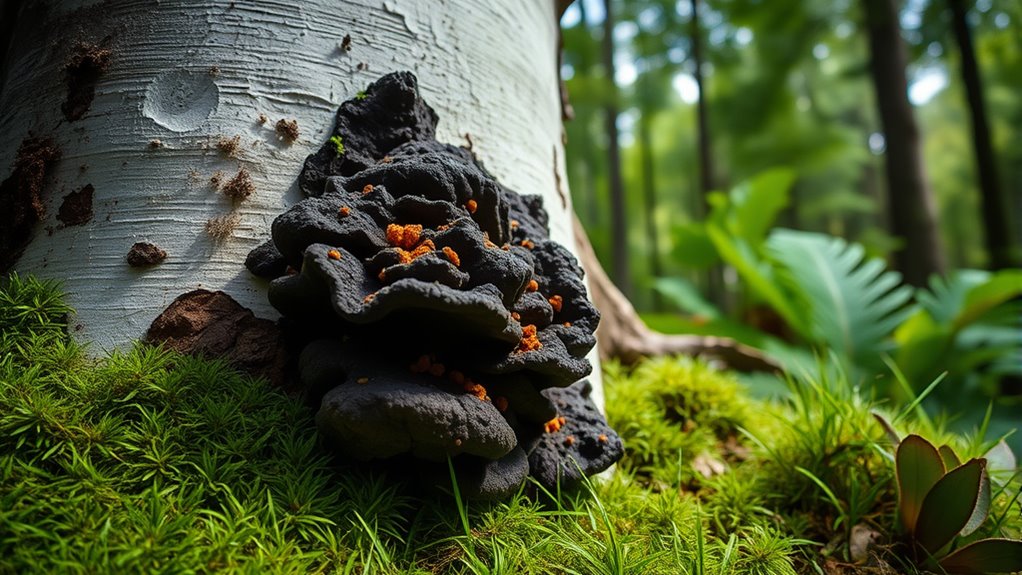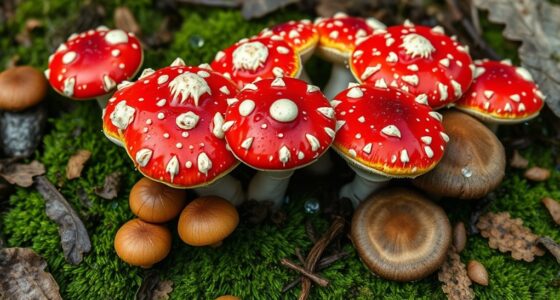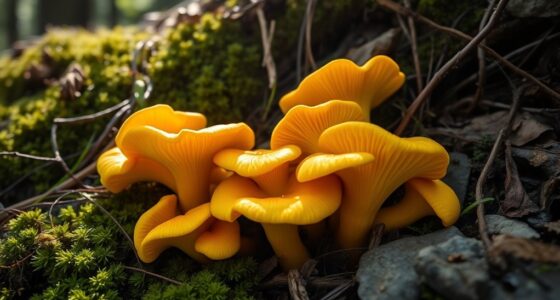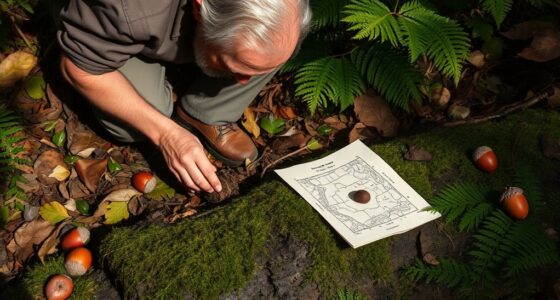To identify chaga, look for rough, blackened masses on birch trees in cold climates, with a cracked, cork-like surface and a dense, orange-brown interior. Avoid soft, moldy, or overly decayed samples to prevent misidentification. When harvesting, use clean tools and only take what’s needed, leaving some behind for future growth. Respect local laws and sustainable practices, ensuring chaga remains available. Explore further to master responsible wildcrafting and conservation methods.
Key Takeaways
- Look for rough, blackened, bark-like masses on birch trees with a cracked surface and orange-brown interior.
- Avoid soft, moldy, or decayed chaga; focus on texture and color differences for accurate identification.
- Harvest during winter using clean tools, leaving some behind to support natural regeneration and ecosystem health.
- Research local laws and regulations to ensure sustainable collection and prevent overharvesting.
- Practice mindful harvesting with respect for nature, fostering a responsible relationship and supporting chaga’s future availability.

Are you confident in your ability to identify chaga mushrooms in the wild? If not, it’s time to trust your intuition and sharpen your skills because the journey to sustainable harvesting begins with clear identification. Chaga grows primarily on birch trees in colder climates, appearing as rough, blackened masses that resemble burnt charcoal. These distinctive growths often protrude from the bark, with a cracked, cork-like surface and a dense, orange-brown interior. To truly connect with this sacred fungus, you must learn to distinguish it from look-alikes, such as certain conks or dead wood, which can be misleading. Wildcrafting tips emphasize patience and careful observation—look for chaga’s unique texture and color, and avoid ones that are soft, moldy, or overly decayed. Remember, harvesting regulations are essential; always research local laws before collecting. Many regions impose restrictions to protect wild populations, ensuring that chaga remains available for future generations and that ecosystems stay balanced. Respect these rules, and never take more than you need, practicing ethical wildcrafting that honors the land. As you venture into the wilderness, remember that learning to identify chaga isn’t just about recognition—it’s about fostering a deep relationship with nature’s medicine cabinet. Your liberation comes from understanding that you’re a steward, not a thief, of these precious resources. When harvesting, use a clean, sharp tool to gently pry the chaga from the bark, avoiding unnecessary damage to the host tree. Always leave some chaga behind to allow for natural regeneration and continued growth. This mindful approach aligns with sustainable harvest practices, ensuring that the chaga community thrives alongside you. Be aware of seasonality; the best time to harvest is typically during winter when the fungus is dormant and easier to identify. Keep in mind that overharvesting depletes local chaga populations and diminishes the forest’s healing potential. Your connection to the land deepens when you harvest responsibly, making each collection an act of reverence rather than exploitation. As you gather, remember that knowledge is power—your ability to identify chaga and adhere to wildcrafting tips and harvesting regulations empowers you to take only what’s needed, preserving this gift for others and future generations. With each foray into the wild, you grow more confident, more liberated, and more attuned to the natural world’s cycles. This sacred relationship fuels your journey toward self-sufficiency and harmony with nature, allowing you to harness chaga’s potent benefits without compromising its sacred existence. Developing a respect for ecosystems is essential to ensuring the sustainability of wild resources.
Frequently Asked Questions
How Can I Differentiate Chaga From Similar-Looking Fungi?
You can differentiate chaga from similar fungi by focusing on mushroom spotting and fungi comparison. Look for its distinctive black, cracked outer surface that resembles burnt charcoal, with a rough, woody texture. Unlike other fungi, chaga grows mainly on birch trees and has a densely pitted, irregular shape. Trust your instincts, observe carefully, and embrace your liberation from fear—knowing you can identify chaga confidently with keen mushroom spotting skills.
Are There Visual Signs Indicating Chaga’s Age or Health?
You can tell Chaga’s maturity and health by examining its surface. Mature Chaga often has a deep, black exterior with a rough, cracked appearance, indicating age. Healthy Chaga shows a consistent, vibrant coloration and firm texture, while signs of fungal health issues include discoloration, soft or crumbly areas, and unusual growths. Trust your senses to identify thriving, mature Chaga, empowering you to harvest responsibly and sustainably.
What Are Common Mistakes Beginners Make in Chaga Identification?
Back in the day, beginners often mistake young chaga for dead or unhealthy specimens. You might overlook key signs like color, texture, and growth patterns, leading to poor harvesting techniques. You should focus on mature, hard, black exterior chaga with a rough surface. Avoid rushing, and store your harvest properly in breathable containers to preserve potency. Recognize these errors, and you’re on your way to true liberation through responsible foraging.
Can Chaga Be Confused With Toxic or Inedible Fungi?
Yes, chaga can be confused with toxic or inedible fungi, so you must be cautious. Fungi toxicity varies widely, and misidentifying a mushroom can lead to serious health issues. To guarantee mushroom safety, learn key features of chaga and avoid risky lookalikes like false tinder conk or inedible fungi. Trust your knowledge, stay vigilant, and always double-check before harvesting, so you can confidently enjoy the benefits of wild fungi without danger.
Does Chaga’s Appearance Vary by Geographic Location?
Like a chameleon blending into its surroundings, chaga’s appearance varies across different regions. Geographic variability and environmental influences shape its size, color, and texture, helping you spot it with confidence. As you explore, embrace this diversity as a sign of nature’s artistry. Don’t let uniformity confine you; instead, celebrate each unique chaga as a symbol of the wild’s freedom and resilience.
Conclusion
Now that you can identify chaga, you can spot its dark, rugged exterior hiding a treasure within. By harvesting responsibly, you preserve its habitat, ensuring future generations can also find this natural marvel. Recognize the signs, respect the environment, and practice sustainability. When you do, you protect the forest, honor tradition, and sustain the magic of chaga. So, look carefully, harvest thoughtfully, and let the forest thrive as you enjoy its gift today and tomorrow.










